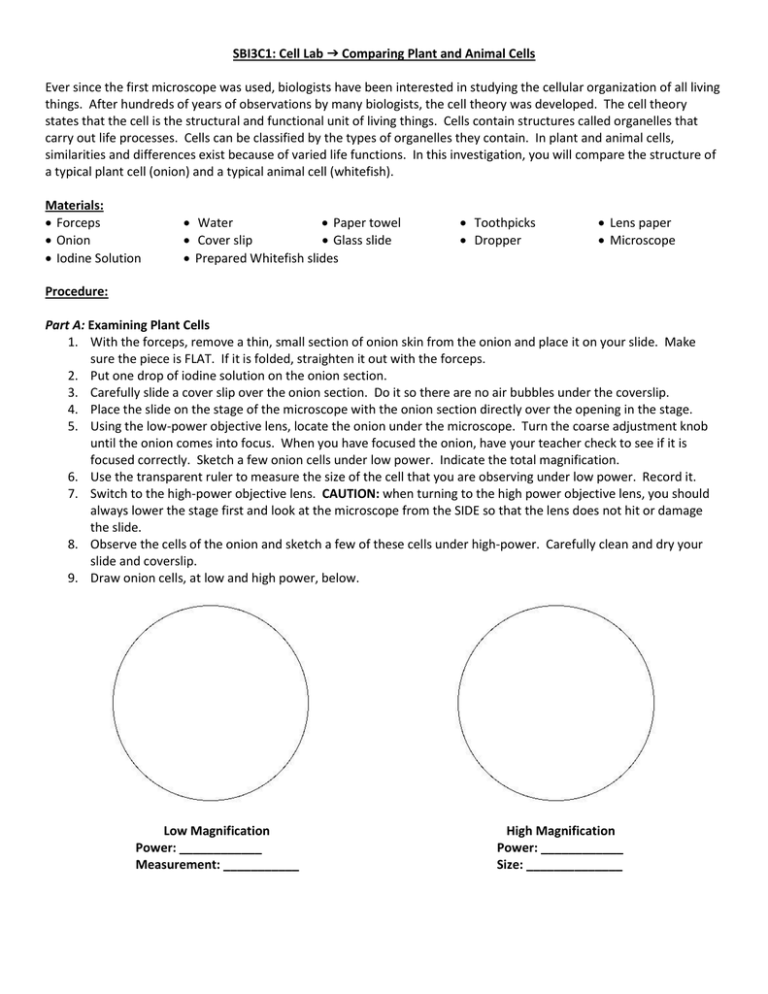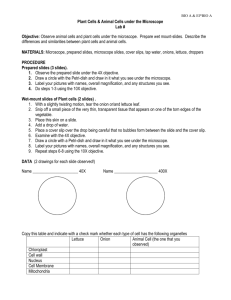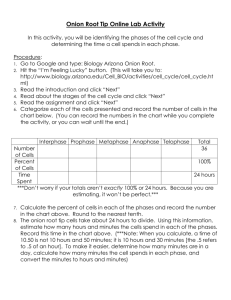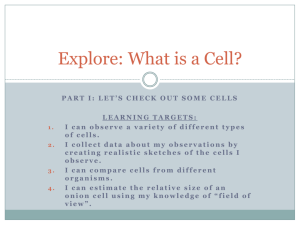SBI3C1: Cell Lab
advertisement

SBI3C1: Cell Lab Comparing Plant and Animal Cells Ever since the first microscope was used, biologists have been interested in studying the cellular organization of all living things. After hundreds of years of observations by many biologists, the cell theory was developed. The cell theory states that the cell is the structural and functional unit of living things. Cells contain structures called organelles that carry out life processes. Cells can be classified by the types of organelles they contain. In plant and animal cells, similarities and differences exist because of varied life functions. In this investigation, you will compare the structure of a typical plant cell (onion) and a typical animal cell (whitefish). Materials: Forceps Onion Iodine Solution Water Paper towel Cover slip Glass slide Prepared Whitefish slides Toothpicks Dropper Lens paper Microscope Procedure: Part A: Examining Plant Cells 1. With the forceps, remove a thin, small section of onion skin from the onion and place it on your slide. Make sure the piece is FLAT. If it is folded, straighten it out with the forceps. 2. Put one drop of iodine solution on the onion section. 3. Carefully slide a cover slip over the onion section. Do it so there are no air bubbles under the coverslip. 4. Place the slide on the stage of the microscope with the onion section directly over the opening in the stage. 5. Using the low-power objective lens, locate the onion under the microscope. Turn the coarse adjustment knob until the onion comes into focus. When you have focused the onion, have your teacher check to see if it is focused correctly. Sketch a few onion cells under low power. Indicate the total magnification. 6. Use the transparent ruler to measure the size of the cell that you are observing under low power. Record it. 7. Switch to the high-power objective lens. CAUTION: when turning to the high power objective lens, you should always lower the stage first and look at the microscope from the SIDE so that the lens does not hit or damage the slide. 8. Observe the cells of the onion and sketch a few of these cells under high-power. Carefully clean and dry your slide and coverslip. 9. Draw onion cells, at low and high power, below. Low Magnification Power: ____________ Measurement: ___________ High Magnification Power: ____________ Size: ______________ Part B: Examining Animal Cells 1. Using the low-power objective lens, locate a few whitefish cells under the microscope. Draw and label them. Indicate the total magnification. 2. Switch to the medium-power objective lens. 3. Observe some fish cells. Draw and label what you see. 4. Carefully put away the slide. Low Magnification Power: ____________ Measurement: ___________ Medium Magnification Power: ____________ Size: ______________ Analysis 1. Using the data table below, use blue ink to indicate which organelles you can see and red ink to indicate which organelles are present in each cell. (T – 5 marks) Cell Parts Whitefish Cell Onion Cells Cytoplasm Nucleus Chloroplast Cell wall Cell Membrane 2. How are plant and animal cells similar in structure? Refer to the table above, along with your notes and text, to answer this question. (T – 3 marks) 3. How are plant and animal cells different? Refer to the table above, along with your notes and text, to answer this question. (T – 3 marks) 4. Estimate the size of the onion cell under low and high magnification. Show all your work! (Diameter of FOV for low power = 4 mm) (T – 10 marks) 5. Estimate the size of the whitefish cell under low and medium magnification. Show all your work! (Diameter of FOV for low power = 4 mm) (T – 10 marks) 6. Keeping all the rules in mind, create a biological drawing of an onion cell under low power. (A – 10 marks)







